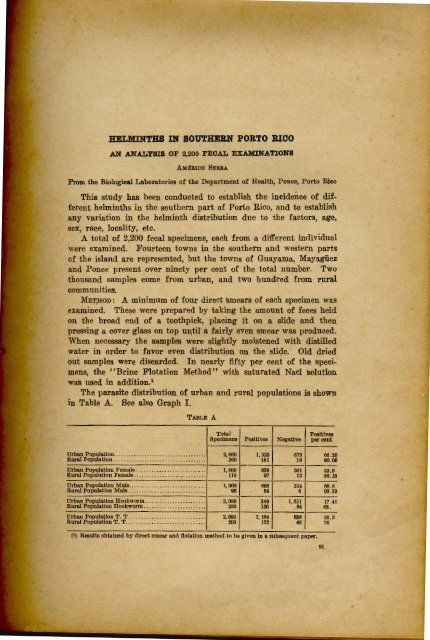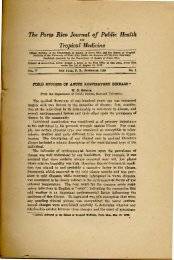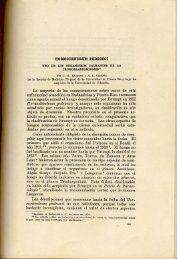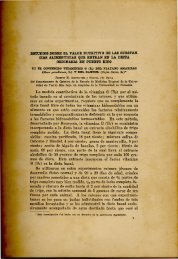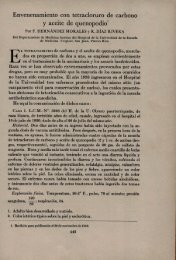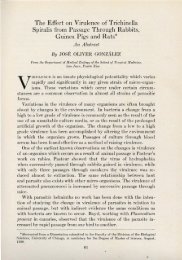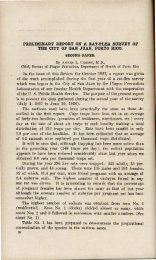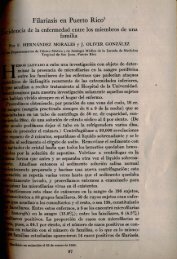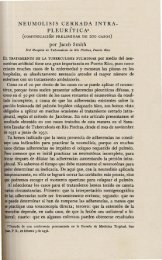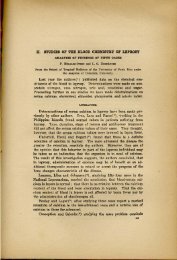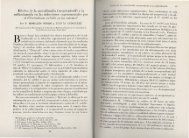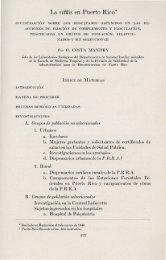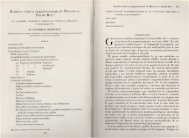Helminths in Southern Porto Rico
Helminths in Southern Porto Rico
Helminths in Southern Porto Rico
Create successful ePaper yourself
Turn your PDF publications into a flip-book with our unique Google optimized e-Paper software.
HELMINTHS IN SOUTHERN PORTO RICO '<br />
AN ANALYSIS OF 2,200 FECAL EXAMINATIONS<br />
AlltRICO SERRA<br />
From t he Biological Laboratories of the Department of Health, Ponce, <strong>Porto</strong> <strong>Rico</strong><br />
This study has been conducted to establish the <strong>in</strong>cidence of different<br />
helm<strong>in</strong>ths <strong>in</strong> the southern part of <strong>Porto</strong> <strong>Rico</strong>, and to establish<br />
any variation <strong>in</strong> the helm<strong>in</strong>th distribution due to the factors, age,<br />
sex, race, locality, etc.<br />
A total of 2,200 fecal 'specimens, each from a different <strong>in</strong>dividual<br />
were exam<strong>in</strong> ed. F ourteen towns <strong>in</strong> the southe rn and western parts<br />
of the island are represented, but the towns of Guayama, Mayagiiez<br />
and Ponce present over n<strong>in</strong>ety per cent of the total number. Two<br />
thousand samples come from urban, and two hundred fro m rural<br />
communities.<br />
ME1;HOD:<br />
exam<strong>in</strong>ed.<br />
A m<strong>in</strong>imum of four direct 'smears of each specimen was<br />
These were prepared by tak<strong>in</strong>g the amount of feces held<br />
on the broad end of a toothpick, plac<strong>in</strong>g it on a slide and then<br />
press<strong>in</strong>g a cover glass on top until a fairly even smear was produced.<br />
When necessary the sample's were slightly moistened with distilled<br />
water <strong>in</strong> order to favor even distribution on the slide. Old dried<br />
out samples were discarded. In nearly fifty per cent of the specimens,<br />
the " Bri ne Flotation Method" with saturated Nael 'solution<br />
was used <strong>in</strong> addition.'<br />
The parasite distribution of urban and rural populations is shown<br />
<strong>in</strong> Table A. See also Graph I.<br />
TABLE A<br />
Total<br />
Positives<br />
Specimens Positives Negative per cent<br />
Urban Population.. .. .. . ....... . .. .......... . . . . .... . 2,000 1,325 67S 66.25<br />
Rural Population. . .. . .... .. . .. .. . . . . . . . . . .. . .... .. .. 200 181 19 90. 015<br />
Urban Population Femal e. ..... .. ... ............ . '" 1,000 639 361 63.9<br />
Rural Population Female............ .... .. ... . .... . 110 117 13 88 .18<br />
Urban Population Male.. ... . . . . . .. . . . . ...... . . .. .... 1,000 ll8II 314 68.6<br />
Rural Population Male.. ........................... . 90 84 6 93.33<br />
Urban Population Hookworm .. .... . . . . .. . . . . . .. .. .. . 2,000 349 1. Ml 17.4~<br />
Rural Population Hookworm . . . .. . . . . . .. . .. .. ..... .. 200 136 64 68.<br />
Urban Population T. T ... ................ ... . . ..... . 2,000 1,164 836 68.2<br />
Rnral Population T . T ... ..... .. .. .............. .. .. 200 1 ~2 48 76<br />
(I) RelDlt.'! obta<strong>in</strong>ed by d irect smear an d flota tion method to be gl.,en In a subseq uent paper.<br />
91
92 PORTO BIOO JOURNAL OJ' PUBLIO HEALTH AND TBOP. HEDICINK<br />
Among the samples from urban population there were 285 from<br />
colored <strong>in</strong>dividuals with sixty-six and two-thirds per cent positive.<br />
Of these 140 were from male's wit h seventy per cent positive, and<br />
145 females with 63.5 per cent posit ive. ·These percentages of positives,<br />
as well as those obta<strong>in</strong>ed for hookworm and Trichuris triehura<br />
were <strong>in</strong>credibly close to the figures obta<strong>in</strong>ed for white <strong>in</strong>dividuals of<br />
correspond<strong>in</strong>g sexes. Of the 1,325 positive urban sampl es, 438 had<br />
two or more parasites and only seventy had th ree or more. .The follow<strong>in</strong>g<br />
table shows the comb<strong>in</strong>ation of parasites <strong>in</strong> two th ousand<br />
urban specimens.<br />
TABL E B<br />
P ercen tage<br />
K <strong>in</strong>d of PlU'asJte Fem&!e Male Tot&! Positive<br />
1. Trlcb~ tri ehnra .<br />
2. Hookworm. Trlohuris trlc bura .<br />
3. Hookworm .<br />
4. Ascaris Inmbrfcoldes , Trlcb~ trlchura .<br />
5. Schistosoma mansoni , T richuri s tricbura .<br />
6 . Bchistosom t. manson!.. ..<br />
7. Hoolnmrm, Schistosoma mansonl T rich ur is trl cbura .<br />
8. T richu ris trlehura, StronlO'lold89 Intest<strong>in</strong>alls .<br />
9 Hookworm, Ascaris lumbrlcoldes Trichuris trlchura .<br />
10. ASClU'1s In mbrlcoldes .<br />
11. Hookworm . Strongyloides Intestlna lls. Trichur is tri ehurt.<br />
. .. .. . .. .. . . .. .. .. . .. .. . .. .<br />
12. Tenia nana , Trichuris trlchura.. .. .... .. ... . ....... .. ..<br />
13. Strongyloides Intest<strong>in</strong>alIs.<br />
14. Hookworm, Strongyloides Intest<strong>in</strong>&1is. . . .. . . . . .. . . . .. . .<br />
16. Hookw orm , Scblstosom a ma nsonl<br />
16. AsClU'ls lumbrieofdes, Schistosoma mansonl, Tri c h~<br />
tr lchura .<br />
17. Asesr ls Inmbrlcoldes, lTookworm .<br />
18. Hookworm, Schistosoma mansoni Strongyloides lutest<strong>in</strong>Blls,<br />
Trichuris trichum .<br />
19. Schistosoma mansonl, Strongyloides Intest<strong>in</strong>aUB, T rI·<br />
390<br />
3~7<br />
89 94<br />
37 61<br />
34 22<br />
24 66<br />
3 21<br />
9 12<br />
7 14<br />
10 II<br />
10 7<br />
6 II<br />
3 6<br />
6 3<br />
2 6 . 6<br />
747<br />
183<br />
88<br />
66<br />
80<br />
24<br />
21<br />
21<br />
19<br />
17<br />
14<br />
8<br />
8<br />
7<br />
6<br />
37.3S<br />
IUS<br />
4 .4<br />
2 .8<br />
4<br />
1.2<br />
1.06<br />
1.06<br />
. ~<br />
•lIS<br />
churls trlchura . 1 2 3 . IS<br />
20. Schlstosoma maosoni, Strongyloides tntest<strong>in</strong>alis . 2 1 3 .15<br />
21. Tenia nana . 2 .. 2 . 10<br />
22. H ooll:worm .Ascar i. lumbrlcoides Schistosoma mansont,<br />
Tricburlq trlchura . 2 2 .10<br />
23. Schistosoma mansonI,Hookworm Tenia naDa. Stronr y·<br />
Ioldes Intestln811s, Trichuris trichura . . . . . . . . . . . . . . . . . . . . . I 1 .OS<br />
24. T enia sag<strong>in</strong>ata, Strongyloides Intestlnalls . 1 1 .06<br />
25. Tenia sag<strong>in</strong>atR . 1 1 .05<br />
26. Hoo kworm Schistosoma manson! Asear!sltmlbrioolde8,<br />
Stro ngyloides IntestlnaUB. Trichur is trlehnra . 1 1 .06<br />
Total .. .. ... 639 - - -·t-- - - I-- - -<br />
686 1. 32.'l 841.26<br />
2<br />
3<br />
3<br />
1<br />
3<br />
6<br />
4<br />
4<br />
.70<br />
.40<br />
.40<br />
. 3.5<br />
. 2.5<br />
.2.5<br />
.20<br />
20
HELMINTHS IN SOUTHERN PORTO RICO 93<br />
By age groups the urban sample's were distributed as shown <strong>in</strong><br />
the follow<strong>in</strong>g table:<br />
TABLE C<br />
PARASITE DISTRIBUTION IN 2,000 URBAN SPECIMENS<br />
,;a<br />
., ., @ eO ..<br />
.. .e ~~ ~ .!!l.Q<br />
il § ~ ..<br />
Aie ;l .t:l"il<br />
]<br />
oW<br />
o -r- " ...<br />
..!l ~<br />
~ i 0 -;::.t: s ~§ 0
94: PORTO RICO JOURNAL OF PUDLIO HEALTH AND TBOP. lIlIlDIO~<br />
TABLE E<br />
PARASITE DIST:BIBUTION IN 1,000 URBAN SPECIMENS-FEMALE<br />
., ., E1§ ..<br />
e- ·~S ~ ;;<br />
!3", oa<br />
Age ] .~~<br />
,, ~<br />
~ .Sl il!l6 '" .!1~ l'l,.,<br />
COl<br />
"<br />
J:l<br />
i ;<br />
~ Z Eo<<br />
~ -.:.!:l 8 ~.a<br />
Eo<<br />
= -"l " ~.!:l .,1:1<br />
.,'" "' ..<br />
Eo< Eo<<br />
- - -- --I- - - '" - ------ '" <br />
Und er 1 fe!ll'. . .... . . . . ... . . .. .. . .. . . . 2 2 ...... ...... ...... ...... ......<br />
1 t o 2 ye ars.. ... .. . . . . . . . . . . . .. .. . .. . 10 2'l 32 8 ..... . 4 ... ... ..... . ...... ......<br />
2 t0 5 yoars . . . . . . . . . . . . . • . . .. •. .• . . .. 2'1 28 50 21 3 6<br />
··..G· ......<br />
5 t o 10 years... ... . . . .. . .. . .. ...... .. 2llO 120 410 274 41 23 ' '' 22' 9 ......<br />
10 to 20 ye",s . .. .. .. .. . ... . .. . ... .. . . . 200 94 294 172 63 26 16 6 ...... ......<br />
20 to 30 years . .. . . .. . . . . .. . .. . ... . . . .. 81 51 132 66 37 ...... 7 ...... ......<br />
30 t o 40 years.. .......... ............. 25 29 M 24 II ...... 2 ...... ...... ......<br />
40 to 50 years.. . . .. . .. . .. .... .. .. . .... 7 9 16 6 1 ...... ...... ...... ...... ......<br />
50 t o 60 years.. . ......... .. . .. . . .. . ... 2 3 s 2 ...... ...... ...... ...... ...... ......<br />
Over 60 years ... .. . . .. . ...... . . .. .. .. 2 3 5 2 ...... ...... ...... ..... . ...... ......<br />
--- - ----- - - - - -------<br />
- - --- - - - ~ - - - - - - - - --<br />
Tolal . . . .. . . . . , . .. . .. . . .. .. .. . . 639 361 1,000 1175 156 59 40 22 6 0<br />
In per cen t . .. . .. . . . ... .. . .. . . ........ 63.9 36.1 100 5 75 15 .6 5.9 4 2. 2 .6 ......<br />
Comparison of the results shown <strong>in</strong> tables C. D. and E. <strong>in</strong> percentage<br />
equivalents will be readily understood by reference to the<br />
follow<strong>in</strong>g graphs:<br />
Graph II for total number of positives<br />
Graph III for Trichuris triehura<br />
Graph IV for Hookworm<br />
Graph V for Ascaris lumbricoides<br />
Graph VI for Schistosoma mansoni<br />
There was a total of 916 specimens from Guayama; 444 females<br />
and 472 male's. For distribution by age groups and sexes see tables<br />
F' and G.<br />
PARASITE DISTB.IBUTION IN 444 SAl\fPLES FB.OM GUAYAMA<br />
FEMALE<br />
..e "<br />
., ., .~f a;;<br />
..<br />
~ ~ "<br />
Age ,J; ~ ~~<br />
! . §~ ,,~<br />
...<br />
-;;:;<br />
s:5<br />
o -r<br />
.!l~ ""<br />
S ·~<br />
~ ., Cl 'cb ""8 'U J:l g.!:l ,," .,c I.l=<br />
~ Z Eo< Eo< III -< " ~ Eo<<br />
- -I--------- '" '" -<br />
~<br />
Under 1 ycsr.. .. .... . . .. .. ... . .. .... . .. ..3· ... .2" ...... ...... .... .. ...... ...... ... ...<br />
1 to 2 years.. . . .. . .. . . .. .. . . . .. . .. . .. 2 1 ...... ...... ...... ...... ...... ......<br />
2to 5 years.. . . ................... . . . 4 4<br />
,"2.j· ....G· ......<br />
H o to years.. . . .. . .. . . . .. .. .. . . . .. . . :rll 88 300 .·2i. · 30 17 3 ......<br />
10 to 20 years. . .. . .. . . .. . . . . . .. . . .. . . . 86 28 114 80 25 7 16 ...... ...... ......<br />
20 t o 30 years.. . ..... . .. .. . ...... .. .. . 3 II 8 2 2 ...... ...... ...... ...... ......<br />
30 to 40 yOlll'll.. .. . . ...... .. . ...... . ... 2 3 5 2 1 ...... ...... ...... ...... ......<br />
40 to 50 years.. . . .. . . •• . •• . . .. . ... . . •. ...... .... i ...... ...... ...... ...... ...... . . --, . ......<br />
60 to 60 years... .. . . . . . .. .. .... . . . . . . . ...... 1 ...... ...... ...... ...... ...... ...... ......<br />
Over 60 years . . . . . . . .. .. . . . ... .. .. . .. ...... ...... ...... ...... ...... ...... ...... ...... ...... .......<br />
--- - - - - - --- - - - - - - - - -<br />
Tol.al. . . . . .. .. .......... . .. . . .. 314 130 444 300 58 24 40 6 3 -.....
HELMINTHS IN SOUTHERN PORTO RICO 95<br />
T.AJlLB G<br />
PARASITE DISTRIBUTION IN 472 SPEOIMENS FROM GUAYAMA<br />
MALE<br />
Age ~ ..<br />
., .... .. Il a., ceg<br />
.. -ctl 0<br />
: to ,t,j.o o~<br />
~ :0""<br />
..<br />
.lol .:/lIla =.. ·dl<br />
·s lll' ~ "" " ~ ~<br />
~b .
96 PORTO RICO JOURNAL OF PUBLIC HEALTH AND TROP. HEDIOINJI<br />
TABL E I<br />
PARASITE DISTRIBUTION IN 277 SPECIMENS FROM PONCE-MALE<br />
~.~<br />
.!l '" ~ ~<br />
.::: " ....c iJ E<br />
",.:;j<br />
A ge ~<br />
" °iO<br />
... ;; ... .- E .;,~I!J ..<br />
~~ "..; .!i~ '"<br />
] ~ ($ ';::: Eo 8 ..c --~<br />
~ ~ 0"<br />
p.. % E- 1;:>-<<br />
Eo O; ....
H EL MINTHS I . ' SOUT HERN PORTO It WO 97<br />
TABL E K<br />
PARASITE DISTRIBUTION IN 235 SPECIMENS FROM MAYAGUEZ<br />
MALE<br />
_ ~ Ii<br />
ceE<br />
i: ~<br />
0<br />
'" .:: " 5<br />
"'::1<br />
::I.e iI' .~ .ci ~; to<br />
~
98 PORTO -RICO JOURNAL OJ' PUBLIC HEALTH AND TBOP. MEDICINB<br />
tions exist for its development and for <strong>in</strong>festation of the barefooted<br />
population, that its figur es come anywhere near th ose of <strong>in</strong>festation<br />
with Trichuris trichura, (See Graph 1.) Due to this larval development<br />
<strong>in</strong> the ground we f<strong>in</strong>d a very low rate of <strong>in</strong>festation <strong>in</strong> ehildren<br />
of urban population. (See Graph IV.)<br />
Parasite <strong>in</strong>festation with most helm<strong>in</strong>ths predom<strong>in</strong>ates <strong>in</strong> th e<br />
uiale sex, especially so, after the first decade of life. This pre dom<strong>in</strong>ance<br />
is most marked <strong>in</strong> the case of parasites requir<strong>in</strong>g a stage of<br />
development outside th e human body. Our figures demonstrate this<br />
very well, except <strong>in</strong> the case of Ascaris Iumbricoides where the <strong>in</strong>cidence<br />
is a little higher for females th an for males. (See Graph V. )<br />
This sexual difference <strong>in</strong> <strong>in</strong>cidence appears most marked for<br />
Schistosoma Mansoni. (See Graph VI.) The reason for this is evident<br />
if we stop to consider the cycle of development of the ehistosoma<br />
mansoni egg outside the human body. ·The egg hatches <strong>in</strong> water and<br />
the myracidium swims toward the light, seek<strong>in</strong>g its proper snail host.<br />
If successful it enters the feelers of a fresh wat cr snail (planorbis)<br />
and is developed <strong>in</strong>to a sporocyst <strong>in</strong> three to four days' time. At<br />
the end of the fifth to sixth day this forms daughter sporocysts which<br />
migrate to the hepato-panereas about the twentieth day and form<br />
t ubular branches. The cer cari ae form <strong>in</strong> these daughter spor oeysts.<br />
Under proper <strong>in</strong>fluence of sun and heat the cercar iae escap e from<br />
the snail and sw<strong>in</strong> around seek<strong>in</strong>g the proper mammalian host.<br />
S<strong>in</strong>ce bath<strong>in</strong>g and swimm<strong>in</strong>g <strong>in</strong> spr<strong>in</strong>ga and rivers is more commonly<br />
practiced by the male sex we naturally expect a higher <strong>in</strong>cidence<br />
of <strong>in</strong>festation with Schi tosoma mansoni <strong>in</strong> this sex.'<br />
·The peak of <strong>in</strong>festation for differ ent parasites oecurs at different<br />
ages. F or Trichuris triehu ra, it reaches over sixty per cent and<br />
occurs from five to twenty years of age, but the parasite is pretty<br />
evenly distributed throughout the other age groups also. The Hookworm<br />
has its peak of thirty to forty per cent <strong>in</strong> the third decade.<br />
It comes down, slowly, <strong>in</strong> the second decade and reaches a very low<br />
level <strong>in</strong> the first.<br />
Ascaris lumbrieoides seldom occurs after the end of the second<br />
decade. Its peak, around ten per cent, is reach ed from one to five<br />
years, Schistosoma man. ani, occurs most fre quently after the close<br />
of the first decad e. Tenia nan a, is not very un commonly found <strong>in</strong><br />
children <strong>in</strong> <strong>Porto</strong> <strong>Rico</strong>. The same is true <strong>in</strong> the United States.<br />
Stiles rep or ts over five per cent <strong>in</strong>festation <strong>in</strong> child ren of a Wash.<br />
<strong>in</strong>gton, D. C. orpha nage. Vl e foun d this paras ite eleven times <strong>in</strong><br />
two th ousand urban 'specimens, an <strong>in</strong>cidence over five per cent.<br />
1 A very bl&'h <strong>in</strong>cidence oucht to provall amoue ...aaber 'lVOmen.
HELMI::-JTHS lK ::iOU'l'llERN PORTO RICO 1:19<br />
Strongyl oide <strong>in</strong>t est<strong>in</strong>alis occurs at any age after <strong>in</strong>fancy. We<br />
foun d it <strong>in</strong> sixty-two <strong>in</strong>stances, an <strong>in</strong>cidence a little over three per<br />
cent. In its differentiation from Hookworm we could pay little at <br />
tention t o the dictum that when larvae are foun d <strong>in</strong> the stools " call<br />
them Strongyloides" and when eggs are found "call them Hookworm<br />
," s<strong>in</strong>ce a large majority of our fecal specimens were over<br />
twenty-four hours old. The differentiation of the filariform larval<br />
stage of these two helm<strong>in</strong>ths offers little difficult y but <strong>in</strong> the differentiation<br />
of their rabdit idiforrn lar val stage one must be most<br />
caref ul and diagnose Strongyloides only after careful exam<strong>in</strong>ation<br />
with the high dry power of the microscope by its comparatively large<br />
genital anlage and th e rather small buccal cavity.<br />
Guayama shows a much higher <strong>in</strong>cidence of Schistosoma mansoni<br />
than Mayagiiez, and Mayagfiez a much higher one than Ponce. (See<br />
Graph VII).<br />
•
100 PORTO RICO JOURN A.L OF PU BLIC HEALTH AND 'I'ROP. MEDICIN E<br />
WM114 ··~H.<br />
~~ttr...l<br />
All M h",i,,1/r HDOkwo,,71 Whip_M.<br />
Oy .sC)(~<br />
6MI'h 1_ ComFri.s4n 0/ 'FbrINi1e I ncic!tJl1ce /;1trlwun<br />
{/rDqn QnrI/JuIOI lbpvklJon_
H El ,~nNTHS II' SOUTHERI' PORTO tu co<br />
101<br />
G~APH .<br />
n_ "PEUCEIiTAQE. OF "PoSITIVE. S"PECIMEMS.<br />
'8v A 0 Eo aQ.ouP.s.
.<br />
102 PORTO RICO JOURNAL OF PUlU,IO HEALTH AND TROP. MEDICINE<br />
1.'.f<br />
7~<br />
t$X<br />
¢J<br />
~<br />
~<br />
~<br />
44f t<br />
06X~ , .<br />
GrapltJIZ-<br />
7richuritf fflchvrq IJ! O/k.-dIlJupt.
BEJ,MJNTBS IN SOUTHERN PORTO RIOO<br />
lOS<br />
~ Hole<br />
~Hm/:lJc<br />
1Gj4<br />
. i<br />
N%.; ~<br />
~ -! .<br />
Gra;rn 1'1.<br />
HooKworm. by Age..Groups.
104 PORTO RICO JOURNAL OF P UBLI C HEALTH AND TBOP. YEDIOlNll:<br />
/-2 Y"~'<br />
sz: ./() yr.s.
HEI,l'.rJNTHS IN SOUTHERN PORTO RICO<br />
lOIS<br />
.60ft<br />
~<br />
.",,:.<br />
IGJJ<br />
~<br />
. . \i<br />
SS%~<br />
..!'c1~ .<br />
e<br />
~ . Mal,.<br />
:~ Femole<br />
Tric"'ri.s 1richvro HooKworm J'clJisr mCln,rO/7; OscQ'rI",s lumb.<br />
'(;repn Ill_ ShOWIng ParpJ'l7e 1l1cid'gncQ by 70wns


